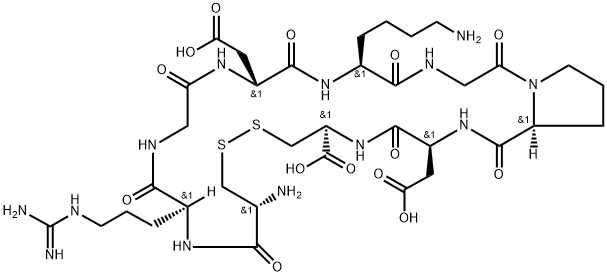1392278-76-0
 1392278-76-0 結(jié)構(gòu)式
1392278-76-0 結(jié)構(gòu)式
基本信息
腫瘤多肽H-CYS-ARG-GLY-ASP-LYS-GLY-PRO-ASP-CYS-OH
H-CYS-CYS-ARG-GLY-ASP-LYS-GLY-PRO-ASP-CYS-OH(DISULFIDE BRIDGE:CYS2-CYS10)
iRGD TFA
c(CRGDKGPDC)
L-Cysteine, L-cysteinyl-L-arginylglycyl-L-α-aspartyl-L-lysylglycyl-L-prolyl-L-α-aspartyl-, cyclic (1→9)-disulfide
物理化學(xué)性質(zhì)
常見問題列表
Integrin
iRGD peptide-mediated tumor penetration occurs in three steps: binding to αv-integrins on tumor vasculature or tumor cells, exposure by proteolysis of a C-terminal motif that binds to neuropilin-1 (NRP-1) and cell internalization. iRGD peptide inserted in the ICOVIR15K fiber C terminus enhances binding and internalization only in MCF7 cells, which express NRP-1 and integrins. iRGD insertion does not impair virus infection and replication. iRGD peptide alone has no obvious effect on gastric cancer cells, and when combined with 5-FU, iRGD peptide (0.3 μmol/mL) enhances the chemotherapy efficacy of 5-FU on gastric cancer cells through NRP1.
iRGD inserted in the oncolytic adenovirus ICOVIR15K (ICOVIR15K-iRGD) enhances early adenovirus dissemination through the tumor mass and elevates the antitumor effect in mice. iRGD (4 mmol/kg, i.v.) in combination with 5-FU significantly suppresses the tumor growth in nude mice bearing human gastric cancer cells.